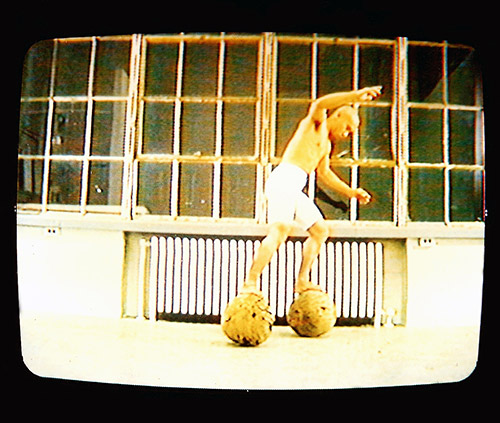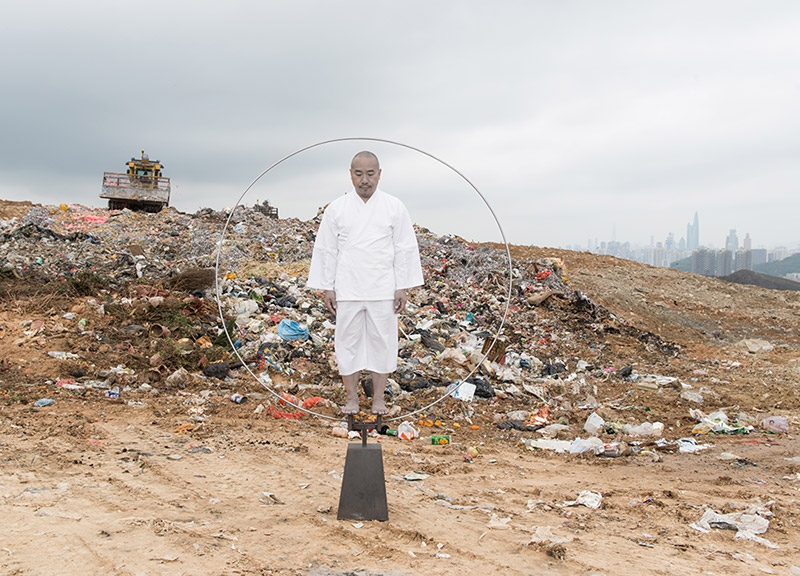Wilson Chik
An ancient Banyan tree: a giant in its own rite, towering. Thousand green leaves shimmering air, each leaf, a moment in life. Nested inside, in the intersection of two gnarly branches, stands Dr. Ho Siu-kee (known as Kee to friends) in all white. Though human, Kee is scaled tiny in this instance, comparatively. Nevertheless man and tree paired, inseparable.
This is how Kee chooses to open, and this is also how Kee chooses to close his recent talk: with a photograph of himself in the midst of a towering Banyan tree. Perhaps, this visual imprint comes to signify a deeper still-motion in progress, a quest of coming full circle not only in his myriad of creations such as this photograph (even though to Kee this is a thought recorded), but in the long line of life-work-art thoughts that purposefully places his body in synthesis among geometries, both personal and spiritual, thus far. We, as the viewers, are placed too in an immediate relationship with him, intimately. Unknowingly we fall into place, so to speak, drawn in by aesthetics and a precision that can only besiege us. For example, Kee standing in the Banyan tree.
Is he merely just standing? At what point is he the subject? Or is the Banyan tree the subject? Or us, the viewers as subjects? Somehow we are all participating. Our senses are homed. When, artfully prompted, the eye (and I) of self-reflection clicks, much akin to a revolving mirror that can change direction: a different view point arises. When does Kee become the object in the photograph? Or does the tree become the object? Or all of us, as viewers, are the objects in this, including the lens, and the photographer taking the photo? This is a case in point that we are all participating, as we are, in this moment and every moment, in a triangulation: a perceiver, in the mesh of culture and nature.
This brings the matter of agency to the surface, prodding at the nuances of how we are connected? Through intersubjectivity or interobjectivity? All layers, no matter how mundane our daily lives happen to be, reveal constantly the relationship that connects each one of us with both animate and inanimate objects. And in a such a spectrum of interdependency, this whole world of experience comes to be through our 5 senses and thoughts. True to this, Kee’s works, once specifically placed by craft, are to be experienced by body and perceived by mind.

Kee’s notable creations span from as early as 1995 to the present day and we are carried right along with each art. In one of his seminal works, Walking on Two Balls (1995), the artist’s body is put into a state where day-to-day balance is compromised, and a new balance must be sought. The challenge is to walk on two wooden balls, sculpted by Kee himself, and of the course, the inherent risk is that Kee might fall. We all watch the video playback half-holding our breath. The graph-like windows, pane by pane, in the background qualitatively chart the act of movement. Our own bodies move right along with Kee’s. A heightened sensitivity and aliveness permeate.
Kee, in his nonchalant way supplemented in the talk, mentioned the previous 9 times failing, which meant losing balance, was just as important as the 10th try in maintaining balance. Each attempt contributes to the body’s dynamism in adapting, which is an on-going and ever-changing process. Each balance lost is the success in finding balance. This process validates an ever-changing state that yields hope in finding new balances. If not, in a fixed state, adaptability would be hard; thus, change would be impossible. Hence, there is no fixed state.
Furthermore, materiality of the human body is extended beyond flesh and bones. In this case, wooden balls. What does this extension tell back about our own adaptability in the extension of material and the inter-connectivity between two seemingly different materials? Here, specifically, flesh and wood. By contact, this act of engagement, we have already bridged materiality. The inner, intra and inter relationships splinter broader, with the mind on board, resolving, from one material to another. An exchange occurs in inclusivity. Ultimately, through different materials, it all turns back into one materiality and mentality – the self, the mind and body – man in flux.

To experience Kee’s art, a tread naturally traverse through an ever-widening and inseparable scope of humanity, culture and nature. We, as either the viewers or participants, no longer can live in isolation or exclusivity as much as we like to deludingly think. In Aureola No.13 (Foot Stand)(2012), a steel ring is constructed, when Kee stands on the self-made pedestal, he is totally enveloped by this circle.
The invisible becomes visible: the border of light or radiance or sheng guang (聖光). Once again, the body placed in the center of this steel circle, does it free or limit the body? And how does the mind perceive this halo? With steel, its materiality challenges with weight and hardness. Does steel amplify the body through its material augmentation?
Or does steel undercut the body by contrast, drawing out more its vulnerability? Which, then, limits or liberates? Kee pushes the body further here by taking a penetrating stand, literally and symbolically, not only with materiality and mentality, but he takes into account context by placing this “holy” (the Germanic root of this word, whole and uninjured) stance directly in locale, situated right in Hong Kong. Sites in Mongkok, a public housing estate, a landfill etc. immediately unravel the mind, body in place!
Here the switching of subject and object brings the background to the forefront, and what’s on the forefront into the background. An inevitable interconnectivity is sought and this is what constitutes this world of experience – life as we know it. As if instantaneously the outer world were to turn inwards and the inner world were to turn outward, we would have to reorient to the degrees of connection, rather than separation, in its throughness.
The aura (steel ring, Kee in white on a pedestal) that draws a crowd in Mongkok. The aura that lights in solitude the dark of Hong Kong living in the pubic domain, in the housing market and in the estate of governance. The aura that can stand as it is in the mounds of rubbish in a landfill. All of our personhood, not just sainthood, is being contested, referenced and pressed. Our senses and mind cannot turn away in disregard, at least I think this is the wish of every artist whose art invokes and or provokes, and also whose art impresses and or expresses. This is high art in situ, biopolitical in nature, examining the extend of limitation and liberation in our own body and in the social dimension at large. This complexity of limitation and liberation then tells back the stories on how have we been living our lives in context, an echo for each one of us to catch, to reflect and to own.
Dr. Ho Siu-kee: a human being in his own rite stands, towering. Trillions of cells shimmering air, each cell, an universe in life. Nested outside, even more expansive, veins and intersections of gnarly branches span an ancient Banyan tree in all shades of green and brown. Though a plant, the Banyan is relatively massive. Nevertheless, man and tree are paired, inseparable.

